Home / SOCl2 Mechanism For Alcohols To Alkyl Halides: SN2 versus SNi
Alcohols, Epoxides and Ethers
SOCl2 Mechanism For Alcohols To Alkyl Halides: SN2 versus SNi
Last updated: March 6th, 2025 |
SOCl2 Mechanism With Alcohols, With And Without Pyridine: Nucleophilic Substitution (SN2) Versus Nucleophilic Substitution With Internal Return (SNi)
- Most of the time, the reaction of alcohols with thionyl chloride is taught as an SN2 reaction. And indeed, on primary alcohols this is definitely the case.
- The problem arises with secondary alcohols, where the reaction can be taught either as a classical SN2 with inversion, or… as a reaction with retention!? via the SNi mechanism. That latter part is what this post is about.
Table of Contents
- “I’m Sorry But Who Taught You That Mechanism” ?
- What Really Happens In The Reaction Of SOCl2 With Secondary Alcohols: The SNi Mechanism
- Nucleophilic Substitution With Internal Return: SNi
- Adding SOCl2 AND Pyridine Leads To Inversion (via SN2)
- Pyridine Shuts Down The SNi Mechanism
- Summary: SOCl2 And Alcohols – SN2 versus SNi
- Notes: How Do Schools In North America Deal With This Dichotomy?
- Quiz Yourself!
- (Advanced) References and Further Reading
1. Conversion Of Alcohols To Chlorides With SOCl2 Proceeds With Inversion…Right? Well, Maybe Not Always
Some time ago I published this post about SOCl2 discussing the mechanism of SOCl2 converting secondary alcohols to alkyl chlorides with secondary through an SN2 pathway:
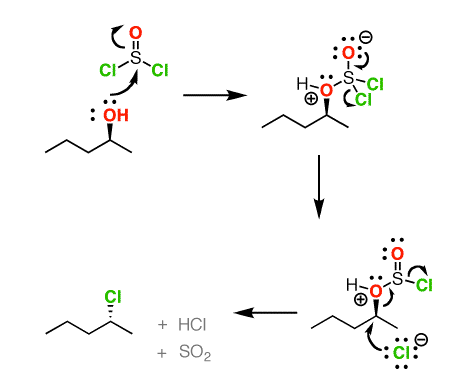
About six months ago this post arrived in the comments:

Rico is correct that the mechanism showing inversion with SOCl2 is not what happens experimentally. When a secondary alcohol is treated with SOCl2 (and nothing else) the usual pathway is retention.
The record should be set straight about this, so this post will cover:
- What really happens in the reaction of SOCl2 with secondary alcohols (the SNi mechanism) and why it gives retention
- Why adding pyridine to SOCl2 results in inversion (via SN2) and not retention
- How do most textbooks and schools across North America deal with this mechanistic dichotomy (hint: most don’t)
- What’s an instructor to do?
2. What Really Happens In The Reaction of SOCl2 With Secondary Alcohols: The SNi Mechanism
In the late 19th century, Paul Walden performed a series of fundamental experiments on the stereochemistry of various reactions of sugars (and sugar derivatives). Walden noted that when (+)-malic acid treated with PCl5, the product was (–) chlorosuccinic acid – a process that proceeded with inversion of stereochemistry. When (+) malic acid was treated with thionyl chloride (SOCl2), however the product was (+)-chlorosuccinic acid. This proceeds with retention of stereochemistry.

How can we understand this?
The reaction of malic acid with PCl5 leading to inversion of stereochemistry is an example of what we now call the SN2 reaction, and Walden was the first to make the observation that the stereochemistry is inverted. In fact the process of stereochemical inversion observed during the SN2 reaction is sometimes called Walden inversion in his honor. By the time most students encounter SOCl2 in their courses, the SN2 is a familiar reaction.
What is much more curious is the observation that malic acid treated with SOCl2 leads to substitution with retention. Sharp readers may recall that “retention” of stereochemistry can be obtained if two successive SN2 reactions occur [double inversion = retention]. Perhaps that is what is going on here? Maybe the carboxylic acid of malice acid can act as a nucleophile in a first (intramolecular) SN2, and then Cl- coming in for the second?
3. Nucleophilic Substitution With Internal Return: SNi
Good idea – but this retention of configuration occurs even in cases where no group can possibly do an intramolecular SN2. There must be something else going on. And after a lot of experimental work, this is the best proposal we have:
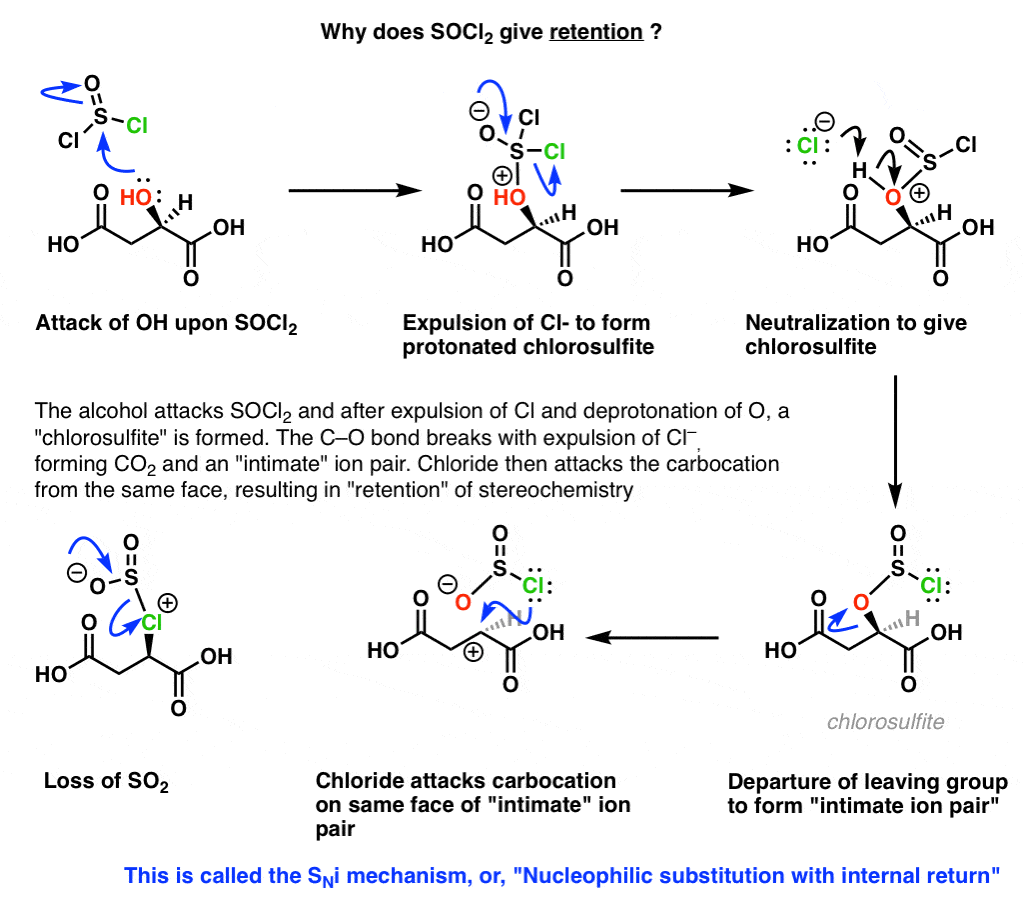
This is called, SNi (nucleophilic substitution with internal return): what happens here is that SOCl2 corrdinates to the alcohol, with loss of HCl and formation of a good leaving group (“chlorosulfite”). The chlorosulfite leaving group can spontaneously depart, forming a carbocation, and when it does so, an “intimate ion pair” is formed, where the carbocation and negatively charged leaving group are held tightly together in space. From here, the chlorine can act as a nucleophile – attacking the carbocation on the same face from which it was expelled – and after expulsion of SO2, we have formation of an alkyl chloride with retention of configuration.
So the chlorosulfite leaving group (SO2Cl) is quite special in that it can deliver a nucleophile (chlorine) to the same face it departs from, with simultaneous loss of SO2.
If it ended there, life might be simpler. But less interesting! [That is the sound of a can of worms being opened].
4.Why Adding SOCl2 AND Pyridine Leads To Inversion via The SN2 Mechanism
Here’s the twist. As it turns out, the stereochemistry of this reaction can change to inversion if we add a mild base – such as pyridine.
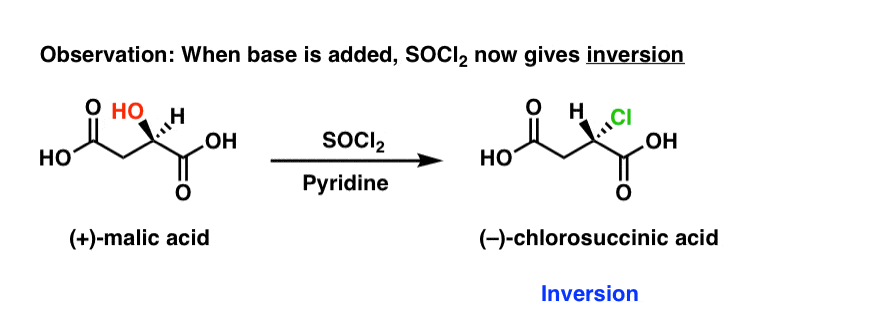
Retention of stereochemistry with SOCl2 alone, inversion with SOCl2 and pyridine. What’s happening here? How does pyridine affect the course of this reaction?
Both reactions form the “chlorosulfite” intermediate. But when pyridine (a decent nucleophile) is present, it can attack the chlorosulfite, displacing chloride ion and forming a charged intermediate. Now, if the leaving group departs, forming a carbocation, there’s no lone pair nearby on the same face that can attack.
In other words, by displacing chloride ion, pyridine shuts down the SNi mechanism.
5. Adding Pyridine To SOCl2 Shuts Down The SNi Mechanism
Even though the SNi can’t occur here, we still have a very good leaving group, and a decent nucleophile – chloride ion – and so chloride attacks the carbon from the backside, leading to inversion of configuration and formation of a C-Cl bond. This, of course, the SN2 reaction.
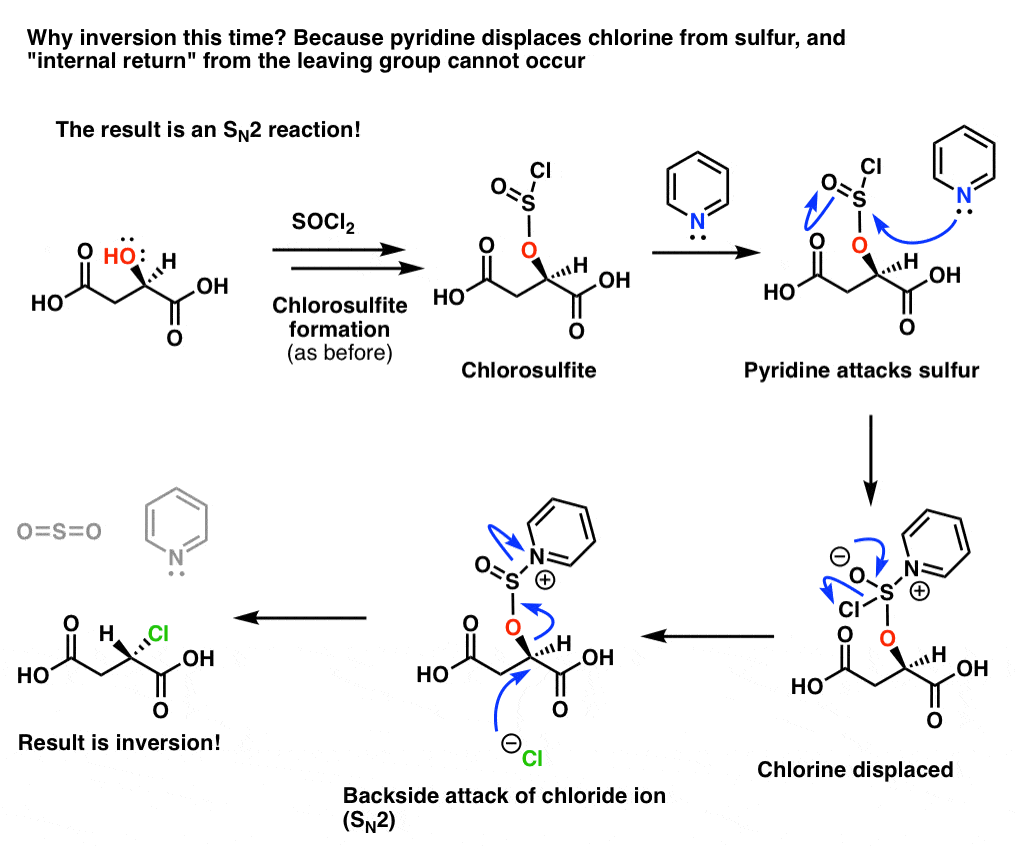
6. Summary: SOCl2 And Alcohols, With Or Without Pyridine – SN2 Versus SNi
The bottom line is this:
SOCl2 plus alcohol gives retention of configuration, SOCl2 plus alcohol plus pyridine gives inversion of configuration (SN2)
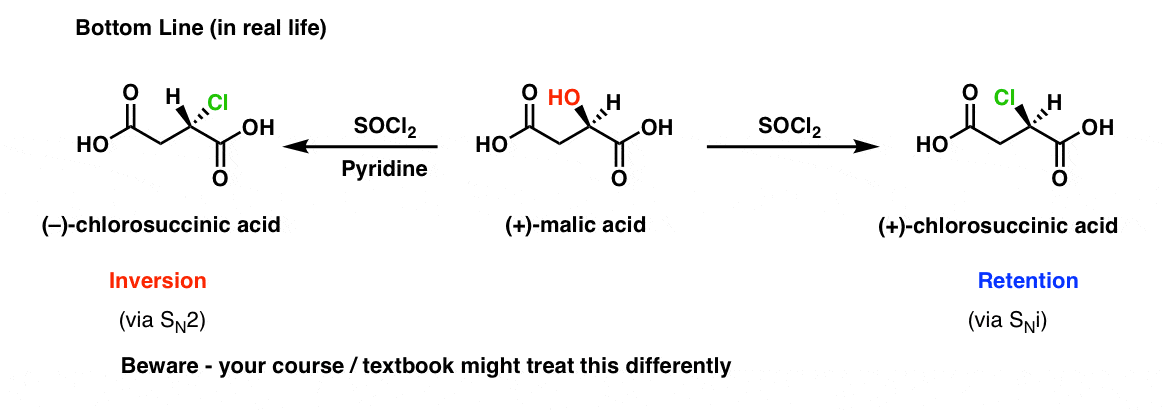
You might be asking, “how common is this SNi mechanism? Is it something which occurs in a large number of other reactions we commonly encounter in introductory organic chemistry?”
To be frank, not really. There are some cases where species called chloroformates can also undergo the SNi with loss of CO2 but this isn’t seen very often at all in your typical first year course.
Notes
Related Articles
Quiz Yourself!
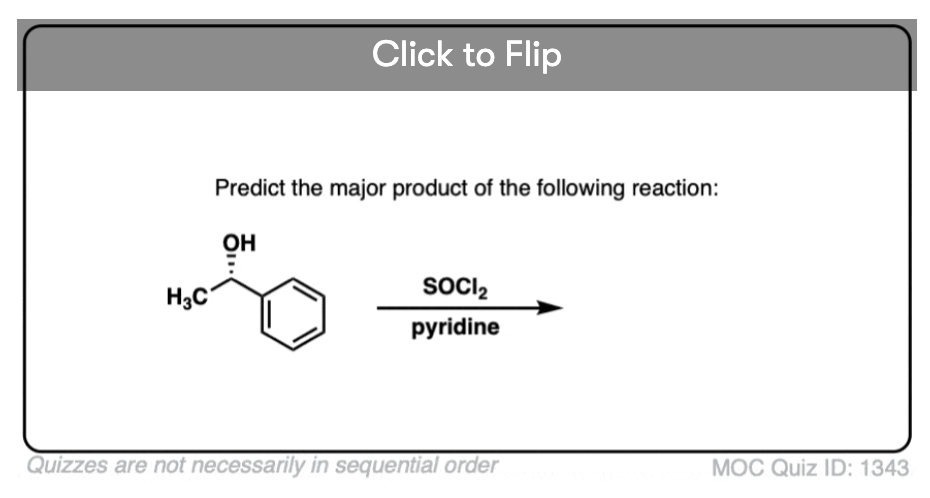
Become a MOC member to see the clickable quiz with answers on the back.
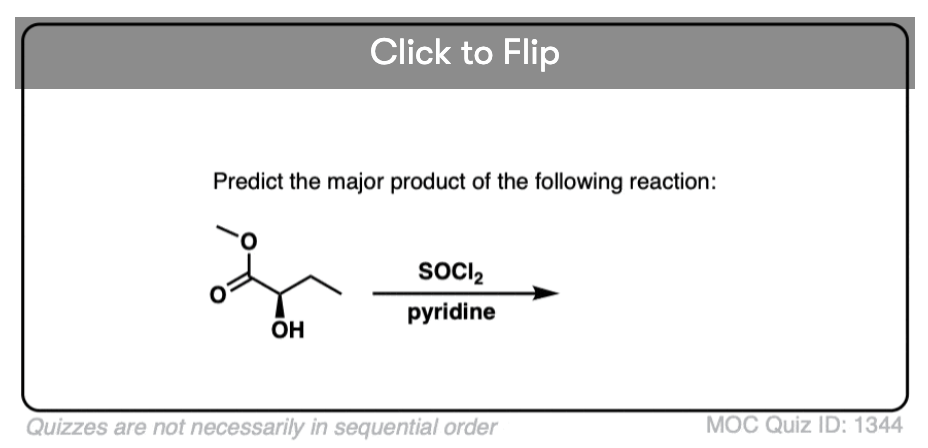
Become a MOC member to see the clickable quiz with answers on the back.
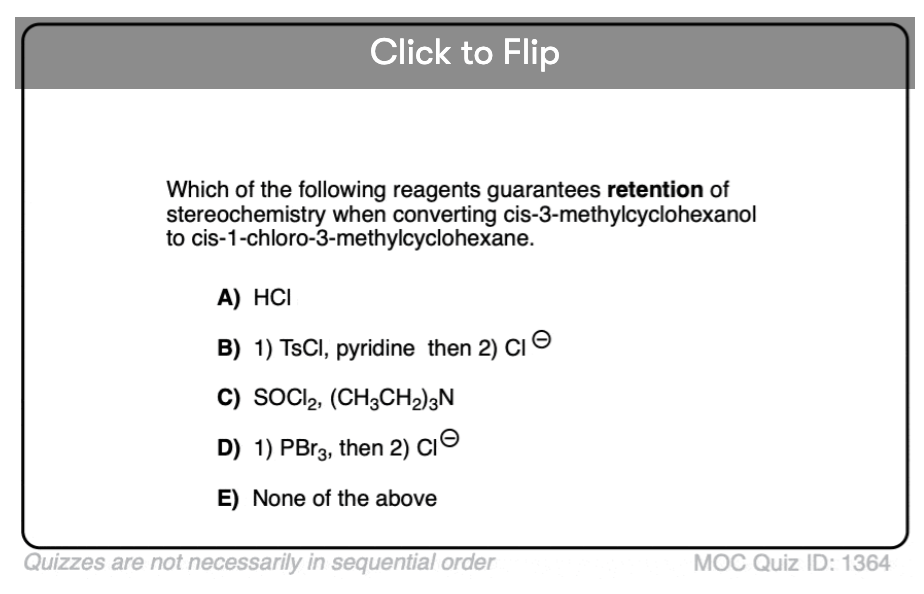
Become a MOC member to see the clickable quiz with answers on the back.

Become a MOC member to see the clickable quiz with answers on the back.
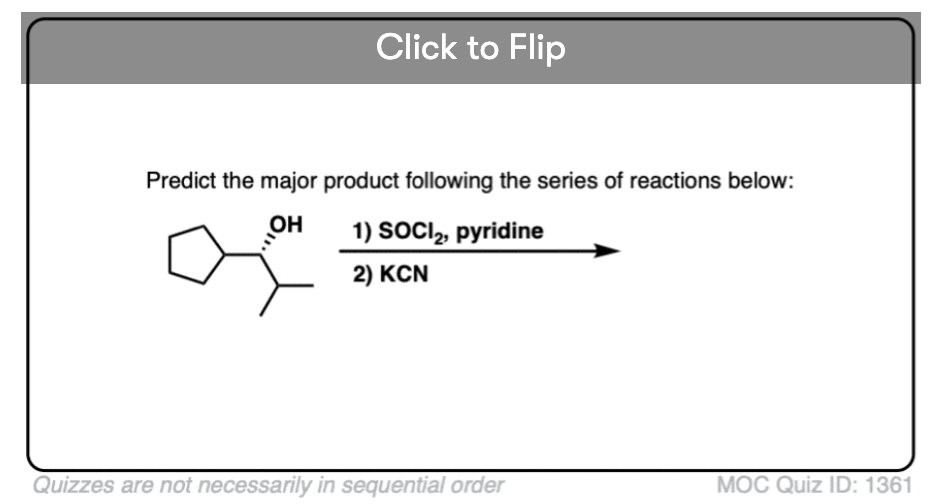
Become a MOC member to see the clickable quiz with answers on the back.
This might not interest everybody so I’m putting it in a note.
How Do Most Textbooks And Schools Across North America Deal With This Mechanistic Dichotomy?
Conversion of alcohols to alkyl halides is a useful transformation because alcohols are poor leaving groups by themselves, whereas alkyl chlorides will readily participate in substitution and elimination reactions. In many introductory organic chemistry courses, SOCl2 has traditionally been used as an example of a reagent that will convert alcohols to alkyl chlorides.
When I consulted my textbook collection for how the mechanism is covered, here’s what I found:
- Wade (5th ed. p 463) Shows conversion of secondary alcohol to secondary alkyl chloride via SNi (with dioxane solvent)
- Solomons (8th ed p. 506-507) Shows conversion of primary alcohol to primary alkyl chloride via SN2. No mention of SNi or stereochemistry.
- McMurry (6th ed p. 608) Shows conversion of primary alcohol to primary alkyl chloride (SN2) No stereochemistry shown.
- Vollhardt (2nd ed p. 288) Shows mechanism (SN2) for primary alcohol; no discussion of SN2.
- Jones (2nd ed p. 830) Shows SN2 of Cl on “R” ; no mention of stereochem
- Clayden, Klein – no mention of SOCl2 as a reagent for converting alcohols to alkyl chlorides
Only one textbook (in this admittedly incomplete sample) mentions the SNi mechanism at all. In four textbooks where SOCl2 is mentioned, the reaction is shown as proceeding through an SN2 mechanism. There’s no warning sign saying, “wait! the SN2 doesn’t happen for secondary alcohols”. If it’s not in the textbook, chances are it won’t be in the course. So it’s not surprising that the most common interpretation of this is that inversion will occur for secondary alcohols:
This leads to situations like the following. Here is a part of an exam key from a very non-obscure R1 university:
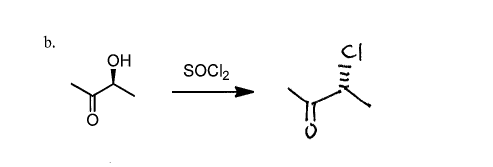
This is a question that tests stereochemistry, and students are expected to write that the SOCl2 proceeds with inversion at a secondary carbon, proceeding through an SN2 mechanism.
There are exceptions. Another school *of similar reputation) tests this reaction as an SNi.
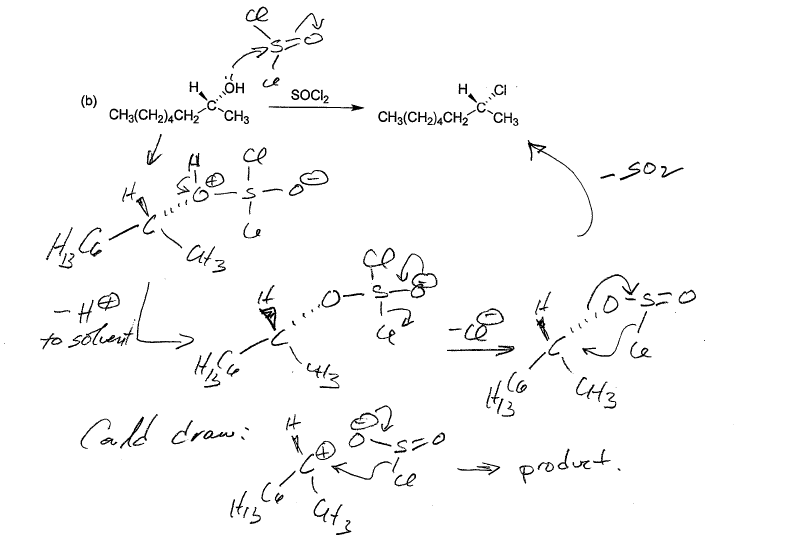
In summary, across North America at least, the discussion of the stereochemistry of SOCl2 reactions with secondary alcohols is a huge mess. I don’t have any data to back this up, but in all my hours of tutoring I have encountered the SNi reaction of SOCl2 being taught… once.
So What’s An Instructor To Do?
First of all, a mea culpa. I drew the SOCl2 as proceeding through inversion and an SN2 process because I’ve aimed the Reagent Guide at the broadest sub-section of students, and it’s most often taught as giving inversion. I should have been more clear that it was more complicated and there was so much confusion on the topic – so I’m grateful to commenters like Rico and others who have brought this to my attention.
Organic chemistry is so wonderfully rich and deep. With the luxury of having already learned all this stuff, I can look back and find it fascinating that just by switching from a primary to a secondary carbon, or from switching to a SO2Cl leaving group, one can change the mechanism from SN2 to SNi. The leaving group can provide its own nucleophile! How cool!
If I was in an introductory class with a full course load and a lot of other lab courses however, my attitude might be different: more like, “Jeezus, YHGTBFKM, is this ever obscure.”
I’ve asked other instructors what they do when they encounter this topic. Here’s what one has to say:
At the second yr / intro level, we keep it very simple. We only talk about it being an SN2 and going with inversion and thus complementary to the HX reactions. We ignore solvent effects for the thionyl chloride reactions.
Here’s another:
I teach it as inversion. Oxygen attacks sulfur, kicks out chloride. Pyridine deprotonates oxygen. Chloride attacks carbon, C-O bond breaks to form 2nd pi bond of SO2, kicks out chloride. Inversion of stereochemistry as chloride attack is SN2-like.
It’s an instructors’ prerogative to pick their battles. I can completely understand how time and attention are limiting factors, and instructors inevitably have to make compromises about what gets included, what gets skipped, and how much detail they choose to include. The fundamental lesson here – to pay attention to stereochemistry of chiral alcohols when converting to alkyl chlorides – is ultimately more important than whether the reaction goes SN2 or SNi in certain situations. However, it would be really nice to see more consistency on this reaction from the textbook writers so that everyone is singing from the same hymnal.
This instructor said it best:
Some of my colleagues just use PCl5 and move on with their lives : – )
(Advanced) References and Further Reading
- Ueber die gegenseitige Umwandlung optischer Antipoden
Walden
Chem. Ber. 1896, 29 (1): 133–138
DOI: 10.1002/cber.18960290127
Original publication on Walden inversion.It is interesting to trace the development of this reaction mechanism through the literature. Early papers were in disagreement regarding the mechanism reconciling the observations that inversion of configuration was observed with base (e.g. pyridine), and retention of configuration without base. - Reaction kinetics and the Walden inversion. Part VI. Relation of steric orientation to mechanism in substitutions involving halogen atoms and simple or substituted hydroxyl groups
W. A. Cowdrey, E. D. Hughes, C. K. Ingold, S. Masterman and A. D. Scott
J. Chem. Soc. 1937, 1252-1271
DOI: 10.1039/JR9370001252
Prof. C. K. Ingold and Hughes developed the ‘SN/E’ nomenclature used to describe reaction mechanisms, now known as the Hughes-Ingold nomenclature. In part C of this paper, they do note the observation that SOCl2 alone reacts with secondary alcohols with retention of configuration, whereas SOCl2+pyridine goes through inversion. However, no mechanism is proposed as they try to fit these observations into their limiting paradigm of SN1 vs. SN2. - The decomposition of chlorosulphinic esters
Michael P. Balfe and Joseph Kenyon
J. Chem. Soc. 1940, 463-464
DOI: 10.1039/JR9400000463
This early paper also features an attempt to rationalize the observed stereochemistries. Retention of configuration is due to “a molecular rearrangement the steric course of which is controlled by the dimensions of the chlorosulphinate molecule”, while inversion is caused by pyridine binding to sulfur. The yield of inverted product can be increased by using an excess of pyridine. - A Study of the Reaction of Alcohols with Thionyl Chloride
William E. Bissinger and Frederick E. Kung
Journal of the American Chemical Society 1947, 69 (9), 2158-2163
DOI: 10.1021/ja01201a030
A nice study on the reaction of alcohols with SOCl2, useful if one is looking for a place to start optimization of this reaction (with regards to stoichiometry). - The Kinetics and Stereochemistry of the Decomposition of Secondary Alkyl Chlorosulfites
Edward S. Lewis and Charles E. Boozer
Journal of the American Chemical Society 1952, 74 (2), 308-311
DOI: 10.1021/ja01122a005 - The Decomposition of Secondary Alkyl Chlorosulfites. II. Solvent Effects and Mechanisms
E. Boozer and E. S. Lewis
Journal of the American Chemical Society 1953, 75 (13), 3182-3186
DOI: 10.1021/ja01109a042
Ref. 4 describes mechanisms for the decomposition of secondary alkyl chlorosulfites. Apparently different mechanisms are in effect when these are decomposed in dioxane or toluene. In dioxane, retention of configuration is observed, while in toluene inverted chlorides are obtained. This is ascribed to the ability of dioxane to coordinate to the carbon and assist with C-S bond cleavage. - Studies in Stereochemistry. XVI. Ionic Intermediates in the Decomposition of Certain Alkyl Chlorosulfites
Donald J. Cram
Journal of the American Chemical Society 1953, 75 (2), 332-338
DOI: 10.1021/ja01098a024
An early paper by Prof. D. J. Cram (UCLA), who was a contemporary of Prof. Saul Winstein (who came up with the concepts of ‘internal return’ and ‘intimate ion pair’ used to describe this SNi mechanism). Prof. Cram would later on receive the Nobel Prize in Chemistry in 1987 for his work on molecular host-guest chemistry. This is the paper rationalizing the differing stereochemistries of the reaction of alcohols with SOCl2 in the presence/absence of base (e.g. pyridine) and is the first paper in the literature describing the reaction of alcohols + SOCl2 as an SNi process. - The textbook March’s Advanced Organic Chemistry (7th) mentions:
“[…] the reaction of alcohols with thionyl chloride to give alkyl halides usually proceeds in this way, with the first step in this case being ROH + SOCl2 à ROSOCl (these alkyl chlorosulfites can be isolated).
Evidence for this mechanism is as follows: The addition of pyridine to the mixture of alcohol and thionyl chloride results in the formation of alkyl halide with inverted configuration. Inversion results because the pyridine reacts with ROSOCl to give ROSONC5H5 before anything further can take place. The Cl– freed in this process now attacks from the rear. The reaction between alcohols and thionyl chloride is second order, which is predicted by this mechanism, but the decomposition by simple heating of ROSOCl is first order”.
Unfortunately, no references are provided.Prof. Jih Ru Hwu (now in Taiwan) attempted to popularize reagents that would react via internal return (such as SOCl2) as ‘ Counterattack Reagents’ early in his career: - Counterattack reagents in organic reactions and in syntheses
Jih Ru Hwu, Bryant A. Gilbert
Tetrahedron 1989, 45 (5), 1233-1261
DOI: 10.1016/0040-4020(89)80123-1 - Silicon reagents in chemical transformations: the concept of ‘counterattack reagent’
R. Hwu, S.-C. Tsay, K. Y. King and D.-N. Horng
Pure Appl. Chem. 1999, 71 (3), 445-451
DOI: 10.1351/pac199971030445
00 General Chemistry Review
01 Bonding, Structure, and Resonance
- How Do We Know Methane (CH4) Is Tetrahedral?
- Hybrid Orbitals and Hybridization
- How To Determine Hybridization: A Shortcut
- Orbital Hybridization And Bond Strengths
- Sigma bonds come in six varieties: Pi bonds come in one
- A Key Skill: How to Calculate Formal Charge
- The Four Intermolecular Forces and How They Affect Boiling Points
- 3 Trends That Affect Boiling Points
- How To Use Electronegativity To Determine Electron Density (and why NOT to trust formal charge)
- Introduction to Resonance
- How To Use Curved Arrows To Interchange Resonance Forms
- Evaluating Resonance Forms (1) - The Rule of Least Charges
- How To Find The Best Resonance Structure By Applying Electronegativity
- Evaluating Resonance Structures With Negative Charges
- Evaluating Resonance Structures With Positive Charge
- Exploring Resonance: Pi-Donation
- Exploring Resonance: Pi-acceptors
- In Summary: Evaluating Resonance Structures
- Drawing Resonance Structures: 3 Common Mistakes To Avoid
- How to apply electronegativity and resonance to understand reactivity
- Bond Hybridization Practice
- Structure and Bonding Practice Quizzes
- Resonance Structures Practice
02 Acid Base Reactions
- Introduction to Acid-Base Reactions
- Acid Base Reactions In Organic Chemistry
- The Stronger The Acid, The Weaker The Conjugate Base
- Walkthrough of Acid-Base Reactions (3) - Acidity Trends
- Five Key Factors That Influence Acidity
- Acid-Base Reactions: Introducing Ka and pKa
- How to Use a pKa Table
- The pKa Table Is Your Friend
- A Handy Rule of Thumb for Acid-Base Reactions
- Acid Base Reactions Are Fast
- pKa Values Span 60 Orders Of Magnitude
- How Protonation and Deprotonation Affect Reactivity
- Acid Base Practice Problems
03 Alkanes and Nomenclature
- Meet the (Most Important) Functional Groups
- Condensed Formulas: Deciphering What the Brackets Mean
- Hidden Hydrogens, Hidden Lone Pairs, Hidden Counterions
- Don't Be Futyl, Learn The Butyls
- Primary, Secondary, Tertiary, Quaternary In Organic Chemistry
- Branching, and Its Affect On Melting and Boiling Points
- The Many, Many Ways of Drawing Butane
- Wedge And Dash Convention For Tetrahedral Carbon
- Common Mistakes in Organic Chemistry: Pentavalent Carbon
- Table of Functional Group Priorities for Nomenclature
- Summary Sheet - Alkane Nomenclature
- Organic Chemistry IUPAC Nomenclature Demystified With A Simple Puzzle Piece Approach
- Boiling Point Quizzes
- Organic Chemistry Nomenclature Quizzes
04 Conformations and Cycloalkanes
- Staggered vs Eclipsed Conformations of Ethane
- Conformational Isomers of Propane
- Newman Projection of Butane (and Gauche Conformation)
- Introduction to Cycloalkanes
- Geometric Isomers In Small Rings: Cis And Trans Cycloalkanes
- Calculation of Ring Strain In Cycloalkanes
- Cycloalkanes - Ring Strain In Cyclopropane And Cyclobutane
- Cyclohexane Conformations
- Cyclohexane Chair Conformation: An Aerial Tour
- How To Draw The Cyclohexane Chair Conformation
- The Cyclohexane Chair Flip
- The Cyclohexane Chair Flip - Energy Diagram
- Substituted Cyclohexanes - Axial vs Equatorial
- Ranking The Bulkiness Of Substituents On Cyclohexanes: "A-Values"
- Cyclohexane Chair Conformation Stability: Which One Is Lower Energy?
- Fused Rings - Cis-Decalin and Trans-Decalin
- Naming Bicyclic Compounds - Fused, Bridged, and Spiro
- Bredt's Rule (And Summary of Cycloalkanes)
- Newman Projection Practice
- Cycloalkanes Practice Problems
05 A Primer On Organic Reactions
- The Most Important Question To Ask When Learning a New Reaction
- Curved Arrows (for reactions)
- Nucleophiles and Electrophiles
- The Three Classes of Nucleophiles
- Nucleophilicity vs. Basicity
- What Makes A Good Nucleophile?
- What Makes A Good Leaving Group?
- 3 Factors That Stabilize Carbocations
- Equilibrium and Energy Relationships
- 7 Factors that stabilize negative charge in organic chemistry
- 7 Factors That Stabilize Positive Charge in Organic Chemistry
- What's a Transition State?
- Hammond's Postulate
- Learning Organic Chemistry Reactions: A Checklist (PDF)
- Introduction to Oxidative Cleavage Reactions
06 Free Radical Reactions
- Bond Dissociation Energies = Homolytic Cleavage
- Free Radical Reactions
- 3 Factors That Stabilize Free Radicals
- What Factors Destabilize Free Radicals?
- Bond Strengths And Radical Stability
- Free Radical Initiation: Why Is "Light" Or "Heat" Required?
- Initiation, Propagation, Termination
- Monochlorination Products Of Propane, Pentane, And Other Alkanes
- Selectivity In Free Radical Reactions
- Selectivity in Free Radical Reactions: Bromination vs. Chlorination
- Halogenation At Tiffany's
- Allylic Bromination
- Bonus Topic: Allylic Rearrangements
- In Summary: Free Radicals
- Synthesis (2) - Reactions of Alkanes
- Free Radicals Practice Quizzes
07 Stereochemistry and Chirality
- Types of Isomers: Constitutional Isomers, Stereoisomers, Enantiomers, and Diastereomers
- How To Draw The Enantiomer Of A Chiral Molecule
- How To Draw A Bond Rotation
- Introduction to Assigning (R) and (S): The Cahn-Ingold-Prelog Rules
- Assigning Cahn-Ingold-Prelog (CIP) Priorities (2) - The Method of Dots
- Enantiomers vs Diastereomers vs The Same? Two Methods For Solving Problems
- Assigning R/S To Newman Projections (And Converting Newman To Line Diagrams)
- How To Determine R and S Configurations On A Fischer Projection
- The Meso Trap
- Optical Rotation, Optical Activity, and Specific Rotation
- Optical Purity and Enantiomeric Excess
- What's a Racemic Mixture?
- Chiral Allenes And Chiral Axes
- Stereochemistry Practice Problems and Quizzes
08 Substitution Reactions
- Nucleophilic Substitution Reactions - Introduction
- Two Types of Nucleophilic Substitution Reactions
- The SN2 Mechanism
- Why the SN2 Reaction Is Powerful
- The SN1 Mechanism
- The Conjugate Acid Is A Better Leaving Group
- Comparing the SN1 and SN2 Reactions
- Polar Protic? Polar Aprotic? Nonpolar? All About Solvents
- Steric Hindrance is Like a Fat Goalie
- Common Blind Spot: Intramolecular Reactions
- Substitution Practice - SN1
- Substitution Practice - SN2
09 Elimination Reactions
- Elimination Reactions (1): Introduction And The Key Pattern
- Elimination Reactions (2): The Zaitsev Rule
- Elimination Reactions Are Favored By Heat
- Two Elimination Reaction Patterns
- The E1 Reaction
- The E2 Mechanism
- E1 vs E2: Comparing the E1 and E2 Reactions
- Antiperiplanar Relationships: The E2 Reaction and Cyclohexane Rings
- Bulky Bases in Elimination Reactions
- Comparing the E1 vs SN1 Reactions
- Elimination (E1) Reactions With Rearrangements
- E1cB - Elimination (Unimolecular) Conjugate Base
- Elimination (E1) Practice Problems And Solutions
- Elimination (E2) Practice Problems and Solutions
10 Rearrangements
11 SN1/SN2/E1/E2 Decision
- Identifying Where Substitution and Elimination Reactions Happen
- Deciding SN1/SN2/E1/E2 (1) - The Substrate
- Deciding SN1/SN2/E1/E2 (2) - The Nucleophile/Base
- SN1 vs E1 and SN2 vs E2 : The Temperature
- Deciding SN1/SN2/E1/E2 - The Solvent
- Wrapup: The Key Factors For Determining SN1/SN2/E1/E2
- Alkyl Halide Reaction Map And Summary
- SN1 SN2 E1 E2 Practice Problems
12 Alkene Reactions
- E and Z Notation For Alkenes (+ Cis/Trans)
- Alkene Stability
- Alkene Addition Reactions: "Regioselectivity" and "Stereoselectivity" (Syn/Anti)
- Stereoselective and Stereospecific Reactions
- Hydrohalogenation of Alkenes and Markovnikov's Rule
- Hydration of Alkenes With Aqueous Acid
- Rearrangements in Alkene Addition Reactions
- Halogenation of Alkenes and Halohydrin Formation
- Oxymercuration Demercuration of Alkenes
- Hydroboration Oxidation of Alkenes
- m-CPBA (meta-chloroperoxybenzoic acid)
- OsO4 (Osmium Tetroxide) for Dihydroxylation of Alkenes
- Palladium on Carbon (Pd/C) for Catalytic Hydrogenation of Alkenes
- Cyclopropanation of Alkenes
- A Fourth Alkene Addition Pattern - Free Radical Addition
- Alkene Reactions: Ozonolysis
- Summary: Three Key Families Of Alkene Reaction Mechanisms
- Synthesis (4) - Alkene Reaction Map, Including Alkyl Halide Reactions
- Alkene Reactions Practice Problems
13 Alkyne Reactions
- Acetylides from Alkynes, And Substitution Reactions of Acetylides
- Partial Reduction of Alkynes With Lindlar's Catalyst
- Partial Reduction of Alkynes With Na/NH3 To Obtain Trans Alkenes
- Alkyne Hydroboration With "R2BH"
- Hydration and Oxymercuration of Alkynes
- Hydrohalogenation of Alkynes
- Alkyne Halogenation: Bromination, Chlorination, and Iodination of Alkynes
- Alkyne Reactions - The "Concerted" Pathway
- Alkenes To Alkynes Via Halogenation And Elimination Reactions
- Alkynes Are A Blank Canvas
- Synthesis (5) - Reactions of Alkynes
- Alkyne Reactions Practice Problems With Answers
14 Alcohols, Epoxides and Ethers
- Alcohols - Nomenclature and Properties
- Alcohols Can Act As Acids Or Bases (And Why It Matters)
- Alcohols - Acidity and Basicity
- The Williamson Ether Synthesis
- Ethers From Alkenes, Tertiary Alkyl Halides and Alkoxymercuration
- Alcohols To Ethers via Acid Catalysis
- Cleavage Of Ethers With Acid
- Epoxides - The Outlier Of The Ether Family
- Opening of Epoxides With Acid
- Epoxide Ring Opening With Base
- Making Alkyl Halides From Alcohols
- Tosylates And Mesylates
- PBr3 and SOCl2
- Elimination Reactions of Alcohols
- Elimination of Alcohols To Alkenes With POCl3
- Alcohol Oxidation: "Strong" and "Weak" Oxidants
- Demystifying The Mechanisms of Alcohol Oxidations
- Protecting Groups For Alcohols
- Thiols And Thioethers
- Calculating the oxidation state of a carbon
- Oxidation and Reduction in Organic Chemistry
- Oxidation Ladders
- SOCl2 Mechanism For Alcohols To Alkyl Halides: SN2 versus SNi
- Alcohol Reactions Roadmap (PDF)
- Alcohol Reaction Practice Problems
- Epoxide Reaction Quizzes
- Oxidation and Reduction Practice Quizzes
15 Organometallics
- What's An Organometallic?
- Formation of Grignard and Organolithium Reagents
- Organometallics Are Strong Bases
- Reactions of Grignard Reagents
- Protecting Groups In Grignard Reactions
- Synthesis Problems Involving Grignard Reagents
- Grignard Reactions And Synthesis (2)
- Organocuprates (Gilman Reagents): How They're Made
- Gilman Reagents (Organocuprates): What They're Used For
- The Heck, Suzuki, and Olefin Metathesis Reactions (And Why They Don't Belong In Most Introductory Organic Chemistry Courses)
- Reaction Map: Reactions of Organometallics
- Grignard Practice Problems
16 Spectroscopy
- Degrees of Unsaturation (or IHD, Index of Hydrogen Deficiency)
- Conjugation And Color (+ How Bleach Works)
- Introduction To UV-Vis Spectroscopy
- UV-Vis Spectroscopy: Absorbance of Carbonyls
- UV-Vis Spectroscopy: Practice Questions
- Bond Vibrations, Infrared Spectroscopy, and the "Ball and Spring" Model
- Infrared Spectroscopy: A Quick Primer On Interpreting Spectra
- IR Spectroscopy: 4 Practice Problems
- 1H NMR: How Many Signals?
- Homotopic, Enantiotopic, Diastereotopic
- Diastereotopic Protons in 1H NMR Spectroscopy: Examples
- 13-C NMR - How Many Signals
- Liquid Gold: Pheromones In Doe Urine
- Natural Product Isolation (1) - Extraction
- Natural Product Isolation (2) - Purification Techniques, An Overview
- Structure Determination Case Study: Deer Tarsal Gland Pheromone
17 Dienes and MO Theory
- What To Expect In Organic Chemistry 2
- Are these molecules conjugated?
- Conjugation And Resonance In Organic Chemistry
- Bonding And Antibonding Pi Orbitals
- Molecular Orbitals of The Allyl Cation, Allyl Radical, and Allyl Anion
- Pi Molecular Orbitals of Butadiene
- Reactions of Dienes: 1,2 and 1,4 Addition
- Thermodynamic and Kinetic Products
- More On 1,2 and 1,4 Additions To Dienes
- s-cis and s-trans
- The Diels-Alder Reaction
- Cyclic Dienes and Dienophiles in the Diels-Alder Reaction
- Stereochemistry of the Diels-Alder Reaction
- Exo vs Endo Products In The Diels Alder: How To Tell Them Apart
- HOMO and LUMO In the Diels Alder Reaction
- Why Are Endo vs Exo Products Favored in the Diels-Alder Reaction?
- Diels-Alder Reaction: Kinetic and Thermodynamic Control
- The Retro Diels-Alder Reaction
- The Intramolecular Diels Alder Reaction
- Regiochemistry In The Diels-Alder Reaction
- The Cope and Claisen Rearrangements
- Electrocyclic Reactions
- Electrocyclic Ring Opening And Closure (2) - Six (or Eight) Pi Electrons
- Diels Alder Practice Problems
- Molecular Orbital Theory Practice
18 Aromaticity
- Introduction To Aromaticity
- Rules For Aromaticity
- Huckel's Rule: What Does 4n+2 Mean?
- Aromatic, Non-Aromatic, or Antiaromatic? Some Practice Problems
- Antiaromatic Compounds and Antiaromaticity
- The Pi Molecular Orbitals of Benzene
- The Pi Molecular Orbitals of Cyclobutadiene
- Frost Circles
- Aromaticity Practice Quizzes
19 Reactions of Aromatic Molecules
- Electrophilic Aromatic Substitution: Introduction
- Activating and Deactivating Groups In Electrophilic Aromatic Substitution
- Electrophilic Aromatic Substitution - The Mechanism
- Ortho-, Para- and Meta- Directors in Electrophilic Aromatic Substitution
- Understanding Ortho, Para, and Meta Directors
- Why are halogens ortho- para- directors?
- Disubstituted Benzenes: The Strongest Electron-Donor "Wins"
- Electrophilic Aromatic Substitutions (1) - Halogenation of Benzene
- Electrophilic Aromatic Substitutions (2) - Nitration and Sulfonation
- EAS Reactions (3) - Friedel-Crafts Acylation and Friedel-Crafts Alkylation
- Intramolecular Friedel-Crafts Reactions
- Nucleophilic Aromatic Substitution (NAS)
- Nucleophilic Aromatic Substitution (2) - The Benzyne Mechanism
- Reactions on the "Benzylic" Carbon: Bromination And Oxidation
- The Wolff-Kishner, Clemmensen, And Other Carbonyl Reductions
- More Reactions on the Aromatic Sidechain: Reduction of Nitro Groups and the Baeyer Villiger
- Aromatic Synthesis (1) - "Order Of Operations"
- Synthesis of Benzene Derivatives (2) - Polarity Reversal
- Aromatic Synthesis (3) - Sulfonyl Blocking Groups
- Birch Reduction
- Synthesis (7): Reaction Map of Benzene and Related Aromatic Compounds
- Aromatic Reactions and Synthesis Practice
- Electrophilic Aromatic Substitution Practice Problems
20 Aldehydes and Ketones
- What's The Alpha Carbon In Carbonyl Compounds?
- Nucleophilic Addition To Carbonyls
- Aldehydes and Ketones: 14 Reactions With The Same Mechanism
- Sodium Borohydride (NaBH4) Reduction of Aldehydes and Ketones
- Grignard Reagents For Addition To Aldehydes and Ketones
- Wittig Reaction
- Hydrates, Hemiacetals, and Acetals
- Imines - Properties, Formation, Reactions, and Mechanisms
- All About Enamines
- Breaking Down Carbonyl Reaction Mechanisms: Reactions of Anionic Nucleophiles (Part 2)
- Aldehydes Ketones Reaction Practice
21 Carboxylic Acid Derivatives
- Nucleophilic Acyl Substitution (With Negatively Charged Nucleophiles)
- Addition-Elimination Mechanisms With Neutral Nucleophiles (Including Acid Catalysis)
- Basic Hydrolysis of Esters - Saponification
- Transesterification
- Proton Transfer
- Fischer Esterification - Carboxylic Acid to Ester Under Acidic Conditions
- Lithium Aluminum Hydride (LiAlH4) For Reduction of Carboxylic Acid Derivatives
- LiAlH[Ot-Bu]3 For The Reduction of Acid Halides To Aldehydes
- Di-isobutyl Aluminum Hydride (DIBAL) For The Partial Reduction of Esters and Nitriles
- Amide Hydrolysis
- Thionyl Chloride (SOCl2)
- Diazomethane (CH2N2)
- Carbonyl Chemistry: Learn Six Mechanisms For the Price Of One
- Making Music With Mechanisms (PADPED)
- Carboxylic Acid Derivatives Practice Questions
22 Enols and Enolates
- Keto-Enol Tautomerism
- Enolates - Formation, Stability, and Simple Reactions
- Kinetic Versus Thermodynamic Enolates
- Aldol Addition and Condensation Reactions
- Reactions of Enols - Acid-Catalyzed Aldol, Halogenation, and Mannich Reactions
- Claisen Condensation and Dieckmann Condensation
- Decarboxylation
- The Malonic Ester and Acetoacetic Ester Synthesis
- The Michael Addition Reaction and Conjugate Addition
- The Robinson Annulation
- Haloform Reaction
- The Hell–Volhard–Zelinsky Reaction
- Enols and Enolates Practice Quizzes
23 Amines
- The Amide Functional Group: Properties, Synthesis, and Nomenclature
- Basicity of Amines And pKaH
- 5 Key Basicity Trends of Amines
- The Mesomeric Effect And Aromatic Amines
- Nucleophilicity of Amines
- Alkylation of Amines (Sucks!)
- Reductive Amination
- The Gabriel Synthesis
- Some Reactions of Azides
- The Hofmann Elimination
- The Hofmann and Curtius Rearrangements
- The Cope Elimination
- Protecting Groups for Amines - Carbamates
- The Strecker Synthesis of Amino Acids
- Introduction to Peptide Synthesis
- Reactions of Diazonium Salts: Sandmeyer and Related Reactions
- Amine Practice Questions
24 Carbohydrates
- D and L Notation For Sugars
- Pyranoses and Furanoses: Ring-Chain Tautomerism In Sugars
- What is Mutarotation?
- Reducing Sugars
- The Big Damn Post Of Carbohydrate-Related Chemistry Definitions
- The Haworth Projection
- Converting a Fischer Projection To A Haworth (And Vice Versa)
- Reactions of Sugars: Glycosylation and Protection
- The Ruff Degradation and Kiliani-Fischer Synthesis
- Isoelectric Points of Amino Acids (and How To Calculate Them)
- Carbohydrates Practice
- Amino Acid Quizzes
25 Fun and Miscellaneous
- A Gallery of Some Interesting Molecules From Nature
- Screw Organic Chemistry, I'm Just Going To Write About Cats
- On Cats, Part 1: Conformations and Configurations
- On Cats, Part 2: Cat Line Diagrams
- On Cats, Part 4: Enantiocats
- On Cats, Part 6: Stereocenters
- Organic Chemistry Is Shit
- The Organic Chemistry Behind "The Pill"
- Maybe they should call them, "Formal Wins" ?
- Why Do Organic Chemists Use Kilocalories?
- The Principle of Least Effort
- Organic Chemistry GIFS - Resonance Forms
- Reproducibility In Organic Chemistry
- What Holds The Nucleus Together?
- How Reactions Are Like Music
- Organic Chemistry and the New MCAT
26 Organic Chemistry Tips and Tricks
- Common Mistakes: Formal Charges Can Mislead
- Partial Charges Give Clues About Electron Flow
- Draw The Ugly Version First
- Organic Chemistry Study Tips: Learn the Trends
- The 8 Types of Arrows In Organic Chemistry, Explained
- Top 10 Skills To Master Before An Organic Chemistry 2 Final
- Common Mistakes with Carbonyls: Carboxylic Acids... Are Acids!
- Planning Organic Synthesis With "Reaction Maps"
- Alkene Addition Pattern #1: The "Carbocation Pathway"
- Alkene Addition Pattern #2: The "Three-Membered Ring" Pathway
- Alkene Addition Pattern #3: The "Concerted" Pathway
- Number Your Carbons!
- The 4 Major Classes of Reactions in Org 1
- How (and why) electrons flow
- Grossman's Rule
- Three Exam Tips
- A 3-Step Method For Thinking Through Synthesis Problems
- Putting It Together
- Putting Diels-Alder Products in Perspective
- The Ups and Downs of Cyclohexanes
- The Most Annoying Exceptions in Org 1 (Part 1)
- The Most Annoying Exceptions in Org 1 (Part 2)
- The Marriage May Be Bad, But the Divorce Still Costs Money
- 9 Nomenclature Conventions To Know
- Nucleophile attacks Electrophile
27 Case Studies of Successful O-Chem Students
- Success Stories: How Corina Got The The "Hard" Professor - And Got An A+ Anyway
- How Helena Aced Organic Chemistry
- From a "Drop" To B+ in Org 2 – How A Hard Working Student Turned It Around
- How Serge Aced Organic Chemistry
- Success Stories: How Zach Aced Organic Chemistry 1
- Success Stories: How Kari Went From C– to B+
- How Esther Bounced Back From a "C" To Get A's In Organic Chemistry 1 And 2
- How Tyrell Got The Highest Grade In Her Organic Chemistry Course
- This Is Why Students Use Flashcards
- Success Stories: How Stu Aced Organic Chemistry
- How John Pulled Up His Organic Chemistry Exam Grades
- Success Stories: How Nathan Aced Organic Chemistry (Without It Taking Over His Life)
- How Chris Aced Org 1 and Org 2
- Interview: How Jay Got an A+ In Organic Chemistry
- How to Do Well in Organic Chemistry: One Student's Advice
- "America's Top TA" Shares His Secrets For Teaching O-Chem
- "Organic Chemistry Is Like..." - A Few Metaphors
- How To Do Well In Organic Chemistry: Advice From A Tutor
- Guest post: "I went from being afraid of tests to actually looking forward to them".
Can you explain SN-2 tetrahedral in ethers when reacted with zncl2 ….
Please…I have exam soon…
Does it have something to do with the bulkyness of pyridine? I have been taught that in the presence of 3-R amine or pyridine SN2 occurs so the bulky nature seems like the only reasonable answer to why the chlorine is prevented from attacking from the same side to form a retention product rather than the inversion product. Am I right to assume this?
I was taught that in Sni mechanism, a 4 membered cyclic Transition state is formed between S , O , Cl and R. Like this :
https://drive.google.com/file/d/1sxNy_jCMSCatIadoRnARrUGabNlvmpXA/view?usp=drivesdk
I really loved the way you dealt with the comment that was probably too harsh on you. If it was any ordinary person they wouldn’t have taken it well at all. And I have learnt so much from your articles that now this is my go-to site for organic. Kudos!!!
Thanks a lot for detailed explanation . Also would like to say that I have read A topic onSNi reaction which is given in the reference book “Organic reactions: structure, mechanism” by Reinhard Bruckner.
It gives good insight how solvent Pyridine changes SNi route SN2 and why in solvent ether reaction of alcohol with thionyl chloride goes by SNi way.
I would be curious to hear your thoughts on the mechanism for converting a carboxylic acid to an acid chloride using SOCl2. I have seen mechanisms where it goes through a 6 membered TS for the first step and the second step while other mechanisms are more stepwise and use the chloride ion to attack.
If you’d like to see advanced problems on similarly (and this) subtle concepts, you should definitely check out the IIT-JEE exam problems.
OK. Where would be a good place to find those?
what is the mechanism in reaction of 1-heptanol with thionyl chloride
Likely a plain old SN2.
Thank you so much for this explanation/follow up! I read both articles for an extra credit assignment and it helped clear things up a ton! You’re the best!
Glad to hear it LDel – you should really thank the original commenter for inspiring the whole post! James
Hi James.
I’m a Chemistry teacher and we recently had a question in a paper in our institute.
The question used an epoxide and reacted with PCl5 to give a dichloro product. Now the doubt that arose amongst us is whether the 2nd Cl atom will add via SNi or SN2.
I have not been able to find any source online which has an example of an epoxide reacting with PCl5.
How SNi differs from SN1 and SN2 ??
Internal return of the leaving group as a nucleophile. Doesn’t really fall into either category.
Can we take pcl5 as a reagent for SNi.??
No, PCl5 will just do SN2.
@Hi everyone..
1. I think The SNi only goes well for primary, secondary alcohols with SOCl2, tertiary alcohols will undergo elimination, along with substitution. Any comments on this…
2. I suppose the kinetics of reaction to be first order, the formation of intimate pair from chlorosulphite is RDS. Any comments…
In the problem with malic acid why does the alcohol group react and not the carboxylic acid? It’s more reactive I thought.
Hi there,
Great explanations! In your mecanism “Why does SOCl2 give retention” you noted that chlorosulfite can be isolated. How is this possible? Do you have any supporting litterature on the subject?
Hi, I would suggest looking it up here, http://pubs.acs.org/doi/abs/10.1021/ja01098a024 . You can also go to March’s Advanced Organic Chemistry and look up “chlorosulfite”.
carboxylic acid won’t interfere with SOCl2 in case of malic acid..? how carboxylic acid remain unaffected..?
plz check example 2 in given link
https://www.masterorganicchemistry.com/2011/12/03/reagent-friday-thionyl-chloride-socl2/
Is this only in case of secondary alcohols?
And is this SNi only for SOCl2 and not others from its family(PBr3, PCl5 etc)
Why????
Only for SOCl2 and not PBr3, PCl5. The mechanism is largely for secondary alcohols. It’s not impossible for it to operate with primary alcohols, but you would be unlikely to be able to tell given that there is no stereocenter possible.
One of my o chem students brought me to this post today. Nice exposition. I’m one of those guilty instructors, both in terms of what I teach and how it shows up on exams.
Here’s a pet peeve: the Lewis structures in this post. The structures never show the lone pair on S so it often appears that S should be charged. Of course, getting all the S chemistry and structural info right is just an added hassle when teaching this material (and I don’t think PCl5 solves this problem either) so maybe we are obliged to simplify? Or as you put it so nicely, we have to pick our battles. Still, there should be some way to inform students that the story we are telling is incomplete, no?
There is another thing here: you (and many others, me too in the past) formulate the initial SN reaction at sulfur (not carbon!) as proceeding via addition/elimination. That is of course an analogy to the reaction of carbonyl compounds. It is probably more realistic to formulate it as a concerted substitution at sulfur. That is because the S=O “double bond” is not really a double bond, but a polarized single bond, thus it may not actually like to react by addition/elimination mechanisms.
See for the similar case of the first step in acid chloride formation from SOCl2, which Henry Rzepa calculated: http://www.ch.imperial.ac.uk/rzepa/blog/?p=6816
As concerns the main question of SN2 vs SNi (with retention) in SOCl2 initiated alcohol chlorinations:
• my experience tells me that generalizations made in textbooks often rely on very few actual examples in the literature, which are introduced at some point and then copied by other authors. Many of the examples are from the older (pre-NMR, HPLC) literature and might not always survive a more accurate reinvestigation with modern analytical techniques.
• the example you give for SNi (malic acid) is maybe not good, because they might show neighboring group effects with double SN2; better examples for SNi are chiral alcohols with no neighboring groups in the molecule.
• The malic acid examples are (with other reaction conditions: PCl5) classical examples for Waldens inversion, but again such old chemistry is often less well understood than textbooks might imply. See for a recent discussion of the Walden examples: http://pubs.rsc.org/en/Content/ArticleLanding/2006/CC/b517461a
• Personally, I have started checking the original literature to most of the reaction examples I teach in my lecture. Also, I hardly use any hypothetical problems any longer in tests, but I search actually performed examples via Reaxys.
Can R-OH +PCL5 show SNi
To the best of my knowledge SNi is mainly observed with SOCl2.
First, I have to say that Rico was wrong by saying that Alcohols and SOCl2 ALWAYS react with retention of configuration.
Sometimes, you can get retention of configuration and sometimes inversion of configuration. The key thing to remember is the solvent use in the reaction.
If you want a better understanding of what is going on you must consult the primary litterature on the topic. I suggest for all of you reading these books and articles :
Carey and Sundberg Part A Advanced organic chemistry
J. Org. Chem., 2013, 78 (5), pp 2118–2127
J. Org. Chem., 1993, 58, pp 2822
and references therein
Why is it necessary for pyridine to act as a nucleophile? Being the stronger base, wouldn’t it just deprotonate the protonated chlorosulfite leaving the chloride free for an SN2 reaction. There seem to be many reasonable variations here. For me with respect to inversion, the simpler the better. Where is the literature on this that will clean up the inversion mechanism?
I’d refer you to March’s Advanced Organic Chemistry (I used 5th ed but any ed. will do) for a full discussion. James
can we use any other base instead of pyridine?
Yes, other bases may be used. The advantage of pyridine in this case is that it is fairly weak (pka of conjugate acid is 4) and generally won’t lead to competing E2 reactions of the resulting alkyl halides. Tertiary amines are stronger bases, with a pKa (of the conjugate acid) of about 10 or so, so elimination starts to become more of a problem.
@Arkya, I suppose that the secondary alcohol is just to prevent the migration of an alkyl group (as the case may be) to form a more stable carbocation. Frankly speaking, I do not see why this shouldn’t take place in a primary alcohol as well.
Could someone please verify?
Is this mechanism of SNi applicable only for secondary alcohols or for all alcohols in general?
I don’t think you’d need to worry about this with primary alcohols since the active site wouldn’t be a stereocenter (hence no stereochemistry to invert or retain).
With tertiary alcohols, the carbocation formed is much more stable so you’re more likely to get a racemic mixture.
Yes, exactly right about point 1.
With tertiary alcohols, the carbocation formed is much more stable. But there are many alkyl groups around carbocation, anion can not attack it because of steric effect i think. So the anion will attack β H, product would be alkene i think.
In SNi mechanism, when carbocation is formed, does carbocation rearrangement occur like common SN1 mechanism?
With reference to the reaction of SOCl2 with secondary alcohol in presence of pyridine, pyridine acts as a base and it removes the proton from HCl, resulting in formation of free Cl- ion, and Cl-, being an effective nucleophile, attacks Chlorosulphite from the back in normal SN2 fashion.
If there are two SN2 reactions then we would expect complete retention of stereochemistry. In the SNi process we are going through an intimate ion pair – there is a carbocation, so we should see some leakage of the optical purity through a pure SN1 type pathway. If we started with an optically pure chlorosulfite I would expect that the optical purity would decrease with increasing reaction temperature or increasing solvent polarity as both of these factors should disrupt the intimate ion pair.
Also I don’t believe that pyridine would be selective for an aliphatic secondary carbon over the electrophilic sulfur, but one could alternatively measure the reaction rate with respect to pyridine concentration. If it’s straight SN2, you’d expect a linear increase in rate with increasing pyridine conc, whereas if it’s the proposed SNi, you’d see a plateau in reaction rate with increased pyridine conc since the slow step will likely be ionization, not attack at sulfur.
I was taught that in this context retention of configuration is due to the fact that two net inversions occur. The first inversion takes place when the amine (or pyridine in this case) performs an Sn2 displacement on the chlorosulfite. This would generate SO2, the chloride ion, and the activated pyridinium moiety. The second inversion occurs when the chloride ion displaces the pyridine group, resulting in an overall retention of stereochemistry. Would there be an easy way to test the mechanism you propose?
Thanks for this, James. I’d say you threw the book on his slapdown! This is clearly a complicated issue.
Now, hindsight is 20/20, but I suppose it makes pretty good sense that chloride, a weak nucleophile, doesn’t displace chlorosulfite in an SN2 fashion.
Could you invoke the thermodynamic stability and entropic favorability of forming SO2 gas as a factor in why chloride might displace chlorosulfite in SN2?
I probably shouldn’t have written “slap down”, I am glad he brought this subject up.
PCl5 is sufficient to result in inversion of alcohols via an SN2 process with chloride as nucleophile so even with hindsight I think it’s hard to see.
In the latest versions of Solomons he says the reaction is done with Pyridine or other amine base. Also there is one sentence in parentheses where he states the reaction occurs with retention if pyridine is absent.
I teach it with inversion because I have rarely heard of anyone treating an alcohol with thionyl chloride without using some amine.